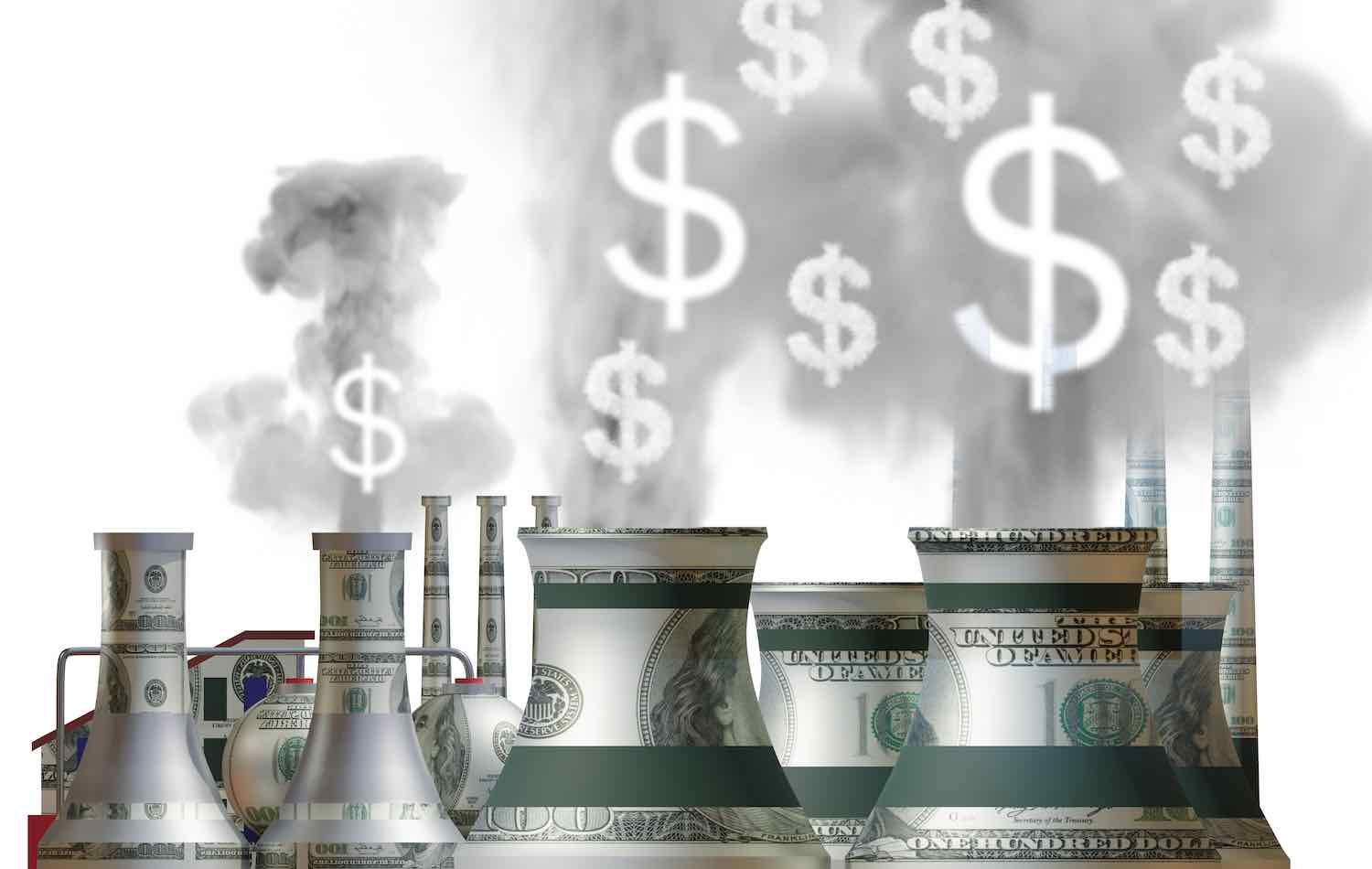ImpactAlpha, Feb. 3 – The carbon footprint of corporations, long regarded as a “nonfinancial” factor, is about to become very material indeed.
The price of carbon is rising more steeply than anyone would have predicted even a year ago. And with market prices now trending higher than the internal prices used by most companies, the hit to corporate balance sheets may also be higher than many chief financial officers have calculated unless companies dramatically reduce their own emissions.
As the price of a ton of carbon has crossed the symbolic threshold of $100 a ton, many companies are scrambling to reduce their own footprints and secure carbon credits at still-low prices. Count the rising price of carbon as one of the energy-transition cost curves that has been greatly underestimated, just like the falling costs of wind, solar and battery power and the rising adoption of electric vehicles in many countries.
This week, prices on the European Union carbon trading market topped €88, or about $100. On the UK’s market, a ton of carbon is fetching £85, or about $115. The price of carbon could reach more than $200 by 2030, before drifting downwards, according to Bloomberg.
“I don’t know why we’re not all jumping for joy that the price is over $100 a ton in Europe,” says CDP North America’s Paula DiPerna. “It’s really a breakthrough and an important development.”
In addition to corporate capital expenditures, the rising price of carbon is affecting business models, deal underwriting and conservation financing. Private equity funds and crypto speculators are getting in the game.
In the most far-reaching visions, we are in the early stages of a revolution in finance in which carbon – or rather the reduction of same – becomes the dominant commodity of the 21st century, a foundational financial asset in the same way the dollar has been since World War II.
“Carbon is $100 a ton. Now what?” is the subject of ImpactAlpha’s Agents of Impact Call No. 37, this Tuesday, Feb. 8 (RSVP now).
Shadow pricing
Carbon has been treated, as the economists say, as an externality. As the earth has warmed by 1.1 degrees Celsius since the pre-industrial era, polluters have essentially borne none of the cost of their emissions to society or the economy.
There still is, of course, no single price of carbon. But for the first time since factories, farms, automobiles and buildings started spewing carbon and other greenhouse gasses into the atmosphere, there are prices on carbon.
The U.S. government’s calculation of the “social cost of carbon,” used to guide climate policy, is due to be adjusted this month from the current calculation of $50 a ton. Prices in the two U.S. regional exchanges have roughly doubled in the past two years, to around $28 a ton for the Western Climate Initiative, which covers California and parts of Canada, and to $13 for the Northeast’s Regional Greenhouse Gas Initiative, or RGGI. Both are expected to go higher this year as regulators tighten their allocations of allowances to companies, driving demand.
Many companies set internal prices to help them understand the potential impact of carbon pricing on their operations and drive low-carbon investment.
Internal corporate carbon prices increased to a median of $25 last year, up from $20 in 2018, according to CDP, which conducts an annual survey of corporations. The prices vary widely, from $1,600 a ton last year, the price set by biotech company Amgen, to $1. GM’s shadow price of $25 helps it evaluate energy efficiency projects.
The number of companies using or planning to use an internal carbon price jumped by 80% over the past five years, or more than 2,000 companies around the globe, according to CDP’s latest survey.
Microsoft charges each business unit a $15 a ton carbon fee based on the emissions they generate, and channels the resulting funds to sustainability projects such as renewable power, energy efficiency and the purchase of carbon offsets. The internal price also drives investment decisions and helps raise awareness and establish a culture of climate accountability.
Host Hotels & Resorts, which operates 80 hotels mostly in North America, has adopted a shadow price of $100 a ton. Some of its properties are in regions with carbon markets, such as the Northeast and California.
“Because these markets are still evolving, carbon may be mispriced, underpriced or subject to high volatility,” the company says. It set the higher price based on guidance from the World Bank and the International Monetary Fund.
Value creation
A carbon tax has been a non-starter so far for most governments. But putting a price on carbon – whether through cap-and-trade systems, voluntary carbon offset markets or other means – is still seen as one of the most effective ways to reduce emissions and accelerate the adoption of clean energy and decarbonization technology.
The rising price of carbon offsets should push companies to invest directly in emissions reductions. Corporations purchased more than 31 gigawatts of clean power through long-term contracts last year. Companies such as Microsoft, Stripe and Shopify are stepping up to place early orders with emerging carbon-removal tech companies, guaranteeing a long-term price and helping to catalyze the market (a crowdsourced list can be found here).
And as more corporations scramble to get out ahead and meet their net-zero pledges, carbon is starting to provide a revenue stream, and therefore a financing model, for hard-to-fund forest conservation, regenerative agriculture and ecosystem restoration projects that sequester carbon.
Voluntary markets topped $1 billion last year, up from around $300 million in 2019, as companies buy verified offsets from projects that plant trees, restore mangroves or sequester carbon in the soil through regenerative farming, or that use technology to suck carbon out of the air.
Already, corporations make up the bulk of private flows to climate finance, spending an average $124 billion in 2019 and 2020, or 40% of such private sector spending, according to CPI’s latest tally. A rising carbon price could push that even higher.
Outliers like Amgen aside, most internal corporate carbon prices lag the regulated (“compliance”) markets. Europe’s Emissions Trading System is the most established such market, along with the two U.S. regional exchanges.
Such outdated pricing assumptions could catch up with corporations when compliance markets are expanded to cover more sectors and companies and fragmented markets start to converge.
“Companies recognize that carbon pricing is a tool they need to understand,” says DiPerna. But the gap between established compliance market prices and most corporate pricing “is an indicator that maybe these companies need to think more about where they would stand relative to a mandatory regime.”
In compliance markets, companies in sectors covered by the markets are awarded a certain amount of credits and have to buy offsets for the balance. Such emissions cost Ryan Air, which is covered by the European ETS system, €150 million last year. And that was before prices doubled.
Or consider ExxonMobil, one of the world’s top emitters. The oil giant released 112 million metric tons of CO2 and other greenhouse gases in 2020. At a price of $100 a ton, that would cost them $11 billion annually – more than its $8 billion average annual earnings. (Exxon reported earnings of $23 billion for 2021, a seven-year high fueled by soaring oil prices).
Saïd Business School’s Robert Eccles and Carbonware.org’s John Mulliken crunched the numbers in the Harvard Business Review: Factoring in emissions from end uses of ExxonMobil’s products – including the tailpipe emissions from vehicles fueling up with its oil and gas – would add $60 billion in liabilities. Even if the company can pass some of that cost to customers, the threat is existential.
But look at it another way: ExxonMobil is sitting on a huge cache of carbon emissions to avoid. As distasteful as it may seem, pricing and paying for avoided emissions could make it more lucrative for ExxonMobil not to pump the oil in the first place, and to capture and sequester the carbon it does emit.
The rising price of carbon may soon mean ExxonMobil’s oil is worth more left in the ground.











